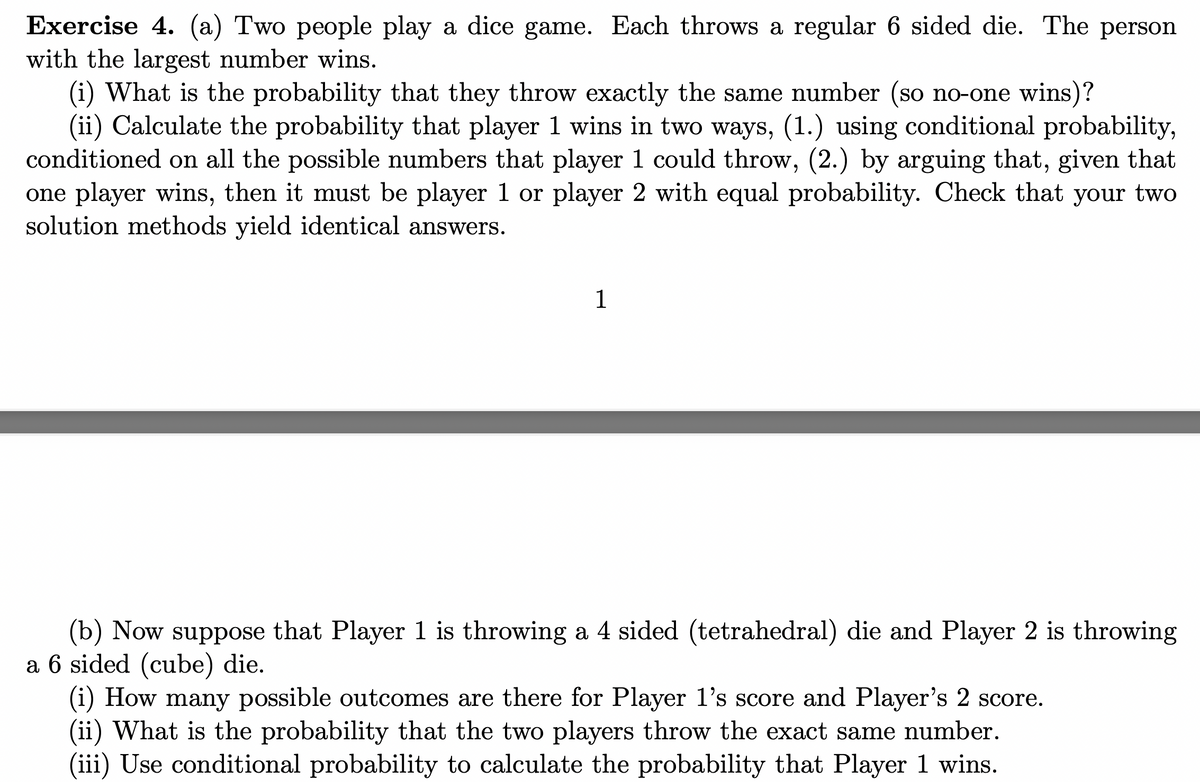Exercise 4. (a) Two people play a dice game. Each throws a regular 6 sided die. The perso with the largest number wins. (i) What is the probability that they throw exactly the same number (so no-one wins)? (ii) Calculate the probability that player 1 wins in two ways, (1.) using conditional probabilit conditioned on all the possible numbers that player 1 could throw, (2.) by arguing that, given th one player wins, then it must be player 1 or player 2 with equal probability. Check that your tw solution methods yield identical answers.
Exercise 4. (a) Two people play a dice game. Each throws a regular 6 sided die. The perso with the largest number wins. (i) What is the probability that they throw exactly the same number (so no-one wins)? (ii) Calculate the probability that player 1 wins in two ways, (1.) using conditional probabilit conditioned on all the possible numbers that player 1 could throw, (2.) by arguing that, given th one player wins, then it must be player 1 or player 2 with equal probability. Check that your tw solution methods yield identical answers.
Holt Mcdougal Larson Pre-algebra: Student Edition 2012
1st Edition
ISBN:9780547587776
Author:HOLT MCDOUGAL
Publisher:HOLT MCDOUGAL
Chapter11: Data Analysis And Probability
Section11.8: Probabilities Of Disjoint And Overlapping Events
Problem 2C
Related questions
Question

Transcribed Image Text:Exercise 4. (a) Two people play a dice game. Each throws a regular 6 sided die. The person
with the largest number wins.
(i) What is the probability that they throw exactly the same number (so no-one wins)?
(ii) Calculate the probability that player 1 wins in two ways, (1.) using conditional probability,
conditioned on all the possible numbers that player 1 could throw, (2.) by arguing that, given that
one player wins, then it must be player 1 or player 2 with equal probability. Check that your two
solution methods yield identical answers.
1
(b) Now suppose that Player 1 is throwing a 4 sided (tetrahedral) die and Player 2 is throwing
a 6 sided (cube) die.
(i) How many possible outcomes are there for Player 1's score and Player's 2 score.
(ii) What is the probability that the two players throw the exact same number.
(iii) Use conditional probability to calculate the probability that Player 1 wins.
Expert Solution
This question has been solved!
Explore an expertly crafted, step-by-step solution for a thorough understanding of key concepts.
Step by step
Solved in 4 steps with 1 images

Recommended textbooks for you

Holt Mcdougal Larson Pre-algebra: Student Edition…
Algebra
ISBN:
9780547587776
Author:
HOLT MCDOUGAL
Publisher:
HOLT MCDOUGAL

Holt Mcdougal Larson Pre-algebra: Student Edition…
Algebra
ISBN:
9780547587776
Author:
HOLT MCDOUGAL
Publisher:
HOLT MCDOUGAL